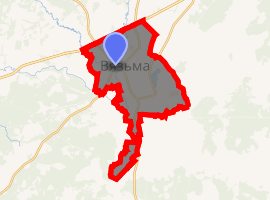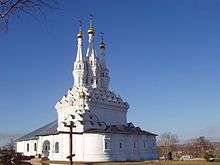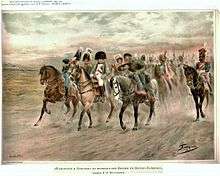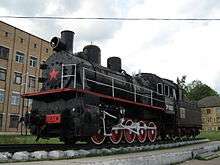Vyazma
Vyazma (Russian: Вя́зьма) is a town and the administrative center of Vyazemsky District in Smolensk Oblast, Russia, located on the Vyazma River, about halfway between Smolensk, the administrative center of the oblast, and Mozhaysk. Throughout its turbulent history, it defended western approaches to Moscow. Population: 57,101 (2010 Census);[3] 57,545 (2002 Census);[9] 59,022 (1989 Census);[10] 44,000 (1970).
Vyazma Вязьма | |
|---|---|
Town[1] | |
In Vyazma | |
.png) Flag _(1780).png) Coat of arms | |
Location of Vyazma 
| |
 Vyazma Location of Vyazma  Vyazma Vyazma (Smolensk Oblast) | |
| Coordinates: 55.2107°N 34.2912°E | |
| Country | Russia |
| Federal subject | Smolensk Oblast[1] |
| Administrative district | Vyazemsky District[1] |
| Urban settlement | Vyazemskoye[1] |
| First mentioned | 1230[2] |
| Area | |
| • Total | 48.58 km2 (18.76 sq mi) |
| Elevation | 240 m (790 ft) |
| Population | |
| • Total | 57,101 |
| • Estimate (2018)[4] | 52,506 (-8%) |
| • Rank | 288th in 2010 |
| • Density | 1,200/km2 (3,000/sq mi) |
| • Capital of | Vyazemsky District[1], Vyazemskoye Urban Settlement[1] |
| • Municipal district | Vyazemsky Municipal District[5] |
| • Urban settlement | Vyazemskoye Urban Settlement[5] |
| • Capital of | Vyazemsky Municipal District[5], Vyazemskoye Urban Settlement[6] |
| Time zone | UTC+3 (MSK |
| Postal code(s)[8] | 215110, 215111, 215113, 215116, 215118, 215119, 215125, 215129, 215169 |
| Dialing code(s) | +7 48131 |
| OKTMO ID | 66605101001 |
| Twin towns | Orša |
| Website | www |
Medieval history and monuments
Vyazma was first mentioned in a chronicle under the year of 1230,[2] although it is believed to be much older than that. The town was named after the river, whose name was from Russian word "вязь" (vyaz'), meaning "bog" or "swamp".[11] At the time, the town belonged to a lateral branch of the Rurikid House of Smolensk, and carried on a lively trade with Narva on the Gulf of Finland.[12] In 1403, the local princes were expelled by Lithuanians to Moscow, where they took the name of Princes Vyazemsky. The most notable among them were Pyotr Vyazemsky, an intimate friend of the poet Alexander Pushkin and a poet himself, and Sophie Viazemski, a French writer, for a time married to Jean-Luc Godard.
In 1494, Vyazma was captured by the Grand Duchy of Moscow and turned into a fortress, of which but a single tower remains. Two important abbeys were embellished with stone churches, including a rare three-tented church dedicated to Our Lady of Smolensk (Hodegetria) and consecrated in 1638 after Polish occupation between 1611 and 1634. A barbican church of the same abbey dates back to 1656, and the town's cathedral was completed by 1676. Other churches are designed mostly in baroque style.

Battles of Vyazma


During the French invasion of Russia in 1812, there was a battle between the retreating French army (up to 37,000 troops) and the Russian army (25,000 men) near Vyazma on October 22, 1812. The vanguard of the Russian army under the command of Lieutenant General Mikhail Miloradovich and a Cossack unit of General Matvey Platov attacked the rearguard corps of Marshal Louis-Nicolas Davout east of Vyazma and cut off his retreat. Owing to the intervention of Eugène de Beauharnais and Józef Poniatowski, Davout managed to break through the Russian army's encirclement.
However, the French army's attempts to hold the heights near Vyazma and the town itself were unsuccessful. By the evening of October 22, Russians seized Vyazma, which had been set on fire by the French. The French lost 6,000 men during the battle; 2,500 soldiers were taken prisoners. The Russians lost around 2,000 men.
In 1941, during World War II, Vyazma was the scene of a battle of encirclement. Red Army units were trapped in the town after it was surrounded by the German Third and Fourth Panzer armies.
Vyazma was occupied by German forces between 7 October 1941 and 12 March 1943. In October 1941, 11 Jews were shot in the town and two were hanged. In December 1941, 117 Jews were killed in a mass execution perpetrated by the Einsatzgruppe B.[13]
The town was heavily damaged in the fighting, then rebuilt after the war. U.S. journalist Quentin Reynolds, of Collier's Weekly, visited Vyazma shortly after the German withdrawal in 1943 and gave an account of the destruction in his book The Curtain Rises (1944), in which he stated that the town's population was reduced from 60,000 to 716, with only three buildings remaining. The Nazis also established two concentration camps in the town, Dulag 184 and Dulag 230. About 80,000 people died there and were buried in mass graves. The victims included Jews, political officers, and POWs.[14]
Administrative and municipal status
Within the framework of administrative divisions, Vyazma serves as the administrative center of Vyazemsky District.[1] As an administrative division, it is incorporated within Vyazemsky District as Vyazemskoye Urban Settlement.[1] As a municipal division, this administrative unit also has urban settlement status and is a part of Vyazemsky Municipal District.[5]
Economy
The town's main industries are engineering, leather working, graphite products, and flax textiles.
Transportation

Vyazma is a major railway junction, with connecting trains from Moscow, St. Petersburg, Kaluga, and Bryansk. It is also located near the main M1 Highway between Moscow and Minsk.
The town is served by the Vyazma Airport.
Education
In terms of education Vyazma has branches of the Moscow State Industrial University, the Smolensk Humanitarian University, the International Academy of Tourism (WF RMAT), and the Moscow State University of Technology and Management, as well as the Vyazemsky Polytechnic College.
Sports
The town association football club, FK Vyazma, plays in the Amateur football league.
The town is known for the aviation-squadron Vyazma Russ which flies in Aero L-39 Albatros jet aircraft.
Notable people
- Boris Almazov (1827–1876), poet, translator and literary critic
- Sergei Davydov (born 1979), football player
- Igor Korobov (1956–2018), chief of GRU
- Anatoli Papanov (1922–1987), film and theater actor
- Nikolai Plotnikov (1897–1979), film and theater actor
- Vasily Stroganov (1858–1938), physician and scientist
References
Notes
- Resolution #261
- Энциклопедия Города России. Moscow: Большая Российская Энциклопедия. 2003. p. 99. ISBN 5-7107-7399-9.
- Russian Federal State Statistics Service (2011). "Всероссийская перепись населения 2010 года. Том 1" [2010 All-Russian Population Census, vol. 1]. Всероссийская перепись населения 2010 года [2010 All-Russia Population Census] (in Russian). Federal State Statistics Service.
- "26. Численность постоянного населения Российской Федерации по муниципальным образованиям на 1 января 2018 года". Federal State Statistics Service. Retrieved January 23, 2019.
- Law #130-z
- Федеральная служба государственной статистики. Федеральное агентство по технологическому регулированию и метрологии. №ОК 033-2013 1 января 2014 г. «Общероссийский классификатор территорий муниципальных образований. Код 66 605 101». (Federal State Statistics Service. Federal Agency on Technological Regulation and Metrology. #OK 033-2013 January 1, 2014 Russian Classification of Territories of Municipal Formations. Code 66 605 101. ).
- "Об исчислении времени". Официальный интернет-портал правовой информации (in Russian). June 3, 2011. Retrieved January 19, 2019.
- Почта России. Информационно-вычислительный центр ОАСУ РПО. (Russian Post). Поиск объектов почтовой связи (Postal Objects Search) (in Russian)
- Russian Federal State Statistics Service (May 21, 2004). "Численность населения России, субъектов Российской Федерации в составе федеральных округов, районов, городских поселений, сельских населённых пунктов – районных центров и сельских населённых пунктов с населением 3 тысячи и более человек" [Population of Russia, Its Federal Districts, Federal Subjects, Districts, Urban Localities, Rural Localities—Administrative Centers, and Rural Localities with Population of Over 3,000] (XLS). Всероссийская перепись населения 2002 года [All-Russia Population Census of 2002] (in Russian).
- "Всесоюзная перепись населения 1989 г. Численность наличного населения союзных и автономных республик, автономных областей и округов, краёв, областей, районов, городских поселений и сёл-райцентров" [All Union Population Census of 1989: Present Population of Union and Autonomous Republics, Autonomous Oblasts and Okrugs, Krais, Oblasts, Districts, Urban Settlements, and Villages Serving as District Administrative Centers]. Всесоюзная перепись населения 1989 года [All-Union Population Census of 1989] (in Russian). Институт демографии Национального исследовательского университета: Высшая школа экономики [Institute of Demography at the National Research University: Higher School of Economics]. 1989 – via Demoscope Weekly.
- Е. М. Поспелов. "Географические названия мира". Москва, 1998, стр. 108.
-

- http://www.yahadmap.org/#village/vyazma-smolensk-russia.546
Sources
- Администрация Смоленской области. Постановление №261 от 30 апреля 2008 г. «Об утверждении реестра административно-территориальных единиц и территориальных единиц Смоленской области», в ред. Постановления №464 от 27 июня 2014 г. «О внесении изменений в реестр административно-территориальных единиц и территориальных единиц Смоленской области». Опубликован: База данных "Консультант-плюс". (Administration of Smolensk Oblast. Resolution #261 of April 30, 2008 On the Adoption of the Registry of the Administrative-Territorial Units and Territorial Units of Smolensk Oblast, as amended by the Resolution #464 of June 27, 2014 On Amending the Registry of the Administrative-Territorial Units and Territorial Units of Smolensk Oblast. ).
- Смоленская областная Дума. Закон №130-з от 28 декабря 2004 г. «О наделении статусом муниципального района муниципального образования "Вяземский район" Смоленской области, об установлении границ муниципальных образований, территории которых входят в его состав, и наделении их соответствующим статусом», в ред. Закона №136-з от 9 декабря 2011 г. «О внесении изменений в областной Закон "О наделении статусом муниципального района муниципального образования "Вяземский район" Смоленской области, об установлении границ муниципальных образований, территории которых входят в его состав, и наделении их соответствующим статусом"». Вступил в силу со дня официального опубликования. Опубликован: "Вестник Смоленской областной Думы и Администрации Смоленской области", №14, часть I, стр. 159, 30 декабря 2004 г. (Smolensk Oblast Duma. Law #130-z of December 28, 2004 On Granting the Status of the Municipal District to the Municipal Formation of "Vyazemsky District" of Smolensk Oblast, on Establishing the Borders of the Municipal Formations Whose Territories It Comprises, and on Granting Them Appropriate Status, as amended by the Law #136-z of December 9, 2011 On Amending the Oblast Law "On Granting the Status of the Municipal District to the Municipal Formation of "Vyazemsky District" of Smolensk Oblast, on Establishing the Borders of the Municipal Formations Whose Territories It Comprises, and on Granting Them Appropriate Status". Effective as of the official publication date.).
Further reading
- (in Russian) Vinogradov, Ivan Pavlovich. (1890) Historical Sketch of Vyazma from ancient times until the 17th century. (Inclusive) (Исторический очерк города Вязьмы с древнейших времен до XVII в. (включительно)) at Runivers.ru in DjVu and PDF formats
External links
- Official website of Vyazma (in Russian)
- Pictures of Vyazma (in Russian)